Abstract
In this study, the effect of these variables on commercial silica NP retention was presented in a fabricated flow model considering only the physical adsorption aspects of silica NP retention. From our observations, it was established that while silica NP concentration, flow rate and salt are key variables in influencing silica NP agglomeration and retention, the effect of temperature was highly subdued. The effect of salt-induced agglomeration was particularly severe at moderate salinity (≈4 wt% NaCl). To mitigate the effect of salt-induced agglomeration, a commonly used anionic surfactant, sodium dodecyl sulfate (SDS) was added to the solution and the silica NP retention was tabulated. An amount of 0.3 wt% SDS was found to negate salt-induced agglomeration significantly, paving the way for use of silica NP solutions, even in the presence of saline conditions. A section on the prospective use of artificial intelligence for this purpose has been included. This study is useful for understanding NP retention behaviour, especially in the presence of salinity and its mitigation using surfactants, in flow applications.
1. Introduction
The recent application of nanotechnology for increasing process efficiency and cost dynamics of various industrial processes has attracted the interest of various oilfield pioneers. Given their superior properties, such as heat tolerance, rheology and optics, various nanotechnology-based products such as nanoparticles (silica NPs, size < 100 nm) and nanofluids (colloidal suspensions of silica NPs in a base fluid) have been found to be of great use as drilling fluid additives, EOR agents, mass transfer enhancement agents, wettability modifiers, rheological stabilizers and sequestration agents in the oil industry [1,2,3,4,5,6].
Previous studies have investigated the role of silica, titania and ZnO NPs for CO2 capture and found that the inclusion of NPs increases carbon-capturing by at least 8–26% [6,7,8,9]. On the other hand, noticeable increases in oil displacement due to interfacial tension (IFT) modification and wettability alteration have been observed in oil recovery [10,11].
Additionally, the silica NPs have found great use as flow agents in heat and mass transfer applications [12,13,14]. Other studies have investigated the role of nanofluids by using them as base fluids or as primary/secondary working fluids in refrigeration either as refrigerants or lubricants [15]. Conventionally, while water is used as a cooling fluid, it comes with limitations such as supercooling degree and inadequate melting and freezing points, along with relatively poor thermal conductivity. After experimental investigation, it was observed that mixing solutes in water improved its basic properties, i.e., primarily increasing its boiling point and reducing its freezing point. These enhancements in various thermos-physical, electrical and rheological properties have also been observed with the addition of smaller nanoparticles of silica, graphene oxide, CuO and graphene [16,17]. The use of nanofluids as nano-refrigerants has the potential to lead to smaller, more compact refrigeration systems which would require less compressor capacity, use less fuel, be more energy efficient and hence, more eco-friendly [18]. Silica NPs also have the potential to increase the solubility between the lubricant and the refrigerant, which would reduce wear and tear and increase the compressor life [19,20,21]. Hence, silica NPs, in this regard, have been found to display exceptional properties and have been touted for future use in refrigeration systems [22,23].
However, it can be observed that silica NPs are agglomeration prone (i.e., reduction in population with an increase in size and no loss of mass), resulting in the minimization of surface energy [24]. The agglomerated silica NPs have a greater propensity to be adsorbed in the flow channels where narrower throats present a major concern. This not only reduces the accessible area in the flow channel but also lowers the population of silica NPs available for participation in further action. This stands out as one issue that affects all the fields of nanoparticle usage that have been discussed above.
Hence, it becomes highly essential to investigate silica NP retention inside flow media for wider inside applications. While past studies have focused on the role of flow rate and concentration in silica NP retention, a detailed study investigating various commonly encountered experimental factors such as pressure, length of channel and salinity, is missing. Hence, in this study, we performed a comprehensive investigation of silica NP retention inside a fabricated flow channel (that mimics a conventional hydrocarbon reservoir or a reservoir micro-channel) under varying experimental conditions. The role of salt-induced agglomeration-based retention is especially novel and highly relevant for industrial applications. Then, a report of the role of an anionic surfactant to mitigate silica NP retention is provided (Figure 1). Finally, a section on the role of artificial intelligence and its role in monitoring and mitigating silica NP retention is elaborated upon and explained in order to describe our planned research direction.
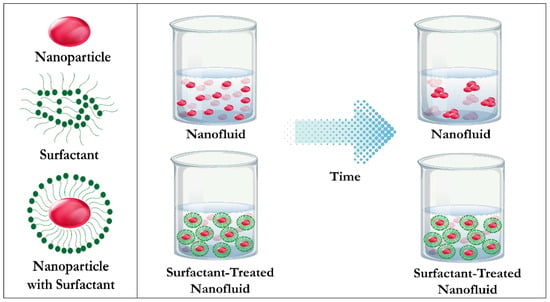
Figure 1.
Stability of nanofluids in the presence of surfactants. The figure is not to scale and is just a representation. In the illustration nanoparticle refers to both individual NPs and NP clusters within the solution.
2. Experimental Section
2.1. Materials
In this study, commercially obtained silica nanopowder (average particle size ≈ 15 nm and purity ≈ 99.5%) from Sisco Research Lab, Taloja, India, and polyacrylamide (PAM, molecular weight ≈ 10 million Dalton, powder form) from SNF Floerger®, Ahmedabad, India, were used. The salt used was sodium chloride (NaCl, purity ≈ 90%) (SD Fine Chemicals, Mumbai, India). The surfactant used was sodium dodecyl sulfate (SDS, purity ≈ 85%, alkalinity = 5 Meq/mL; sodium chloride and sodium sulfate: 8%; unsulfated alcohols: 4%) (Sisco Research Lab, Taloja, India). For all experiments, only degassed and deionized water obtained from a Millipore Elix-10 purification setup (Millipore, Burlington, NJ, USA) was used. All measurements were performed using a highly accurate digital weighing balance (ME204/A04 with a repeatability of 0.1 mg) (Mettler Toledo, Columbus, India). The other experimental aids used in the study were a digital stirrer with a hot plate IKA-C-MAG-HS7 ((IKA, Staufen, Germany), speed 0–1200 rpm), an industrial mixer ((Hamilton Beach, Glenn Allen, AK, USA), speed 0–6000 rpm) and a digital temperature-controlled sonicator (Labman, Chennai, India) with a rating of 100 W, 25 kHz.
2.2. Synthesis of the Two-Step silica Nanofluid
The nanofluid used in this study was synthesized using the previously described 2-step method [25]. In the 2-step synthesis method, the commercially obtained silica nanopowder is dispersed in a base fluid, mainly water. Compared to other methods of nanofluid fabrication, the 2-step method has the advantage of being cheap, readily available and is less manpower-intensive [26,27,28]. In this study, nanofluids of the desired wt% were prepared by carefully measuring the nanopowder (0.1 to 1 wt%) using the digital weighing balance in a 1000 ppm PAM solution. Initially, the 1000 ppm PAM solution was prepared by carefully dispersing 1 g of PAM in 1 l of water. The solution was mixed at 600 rpm for 8 h to ensure complete solubility of PAM and was checked regularly to ensure no flocculates were present. The measured nanopowder was then dispersed in the PAM solution using the industrial mixer (1500 rpm for 5 min). The stirred mixture was then homogenized for 30 min using the sonicator. Due diligence was taken to ensure that the nanofluid did not overheat, as an increase in temperature is detrimental for nanofluid stability. The surfactant treated nanofluids were prepared by carefully dispersing the surfactant (in a measured quantity) inside the nanofluid using the magnetic stirrer (at 300 rpm for 30 min). Further tests of the nanofluid were performed using a Malvern Nano ZS DLS unit, and the samples were diluted by taking 1 part sample and 19 parts DI water. This procedure has been used to prepare silica NPs in past studies [7,29,30].
2.3. Nanoparticle Retention Experiments
The silica NP retention experiments were performed using fabricated synthetic sand packs using sand of uniform shape and size. The sand was procured from a vendor (M/S Might Scientific Sales, Lucknow) who sold the sand under the category of medium-size rough sand and was carefully cleaned, sieved and dried before use. The sand used in this study had a uniform size which ranged from 200–380 µm. These fabricated sand packs closely resemble the oil reservoirs of sandstone origin and are hence most apt for this study [6,31]. The sand used in this study was characterized using an XRD machine (X-Ray Diffractometer D8 Advance, Bruker, India) and the mineral composition of the sand was defined as quartz (88 wt%), kaolinite (6 wt%), feldspar (2 wt%) and chlorite (1 wt%) [32]. The sand was then rammed inside stainless steel packs of varying length (6 and 24 inch). The determination of porosity and permeability of sand packs was done by employing standard oilfield practices, as mentioned in past studies [33]. All sand packs, except for those used in salt-tolerability tests, were 100% saturated with pure water. The salt-tolerability tests were performed using saline water with the desired salt concentration (0–4 wt% NaCl). The inflow and outflow of the sand packs was carefully tabulated using the syringe pump and a graduated cylinder, respectively. All experiments were performed without any confining pressure and at ambient temperatures, unless stated otherwise. The silica NP-retention experiments were performed in a fabricated sand pack instead of any other flow channel since (1) it is easy to fabricate and (2) silica NP retention is a major concern which has, as of yet, not been explored fully in other studies which have promoted silica NP application in oilfield conditions.
3. Results and Discussion
The section reports the initial observations obtained from the synthesis of the silica nanofluids. The section following is related to the studies detailing silica NP retention under varying conditions (length of sand pack, concentration, flow rate of injection and temperature). Next, silica NP retention in saline media was observed and reported. Finally, the role of the surfactant SDS, was reported in the presence of salt to better understand the role of surfactants in minimizing silica NP retention in moderately saline reservoirs.
3.1. Synthesis of Two-Step silica Nanofluids
On removal of the fluid from the sonicator, the nanofluids were observed using a DLS machine to establish their particle size and zeta potential. Visually, the nanofluids appeared to be milky white with an increase in silica NP concentration, further increasing the milky nature of the nanofluid. The average particle size and zeta potential values of the nanofluids are presented in Table 1. All the nanofluids exhibited sizes that are several times larger than their original size (15 nm). This can be attributed to the preparation method, where it was often found that the two-step method leads to the formation of silica NP clusters due to the mechanical nature of their mixing [25]. The increase in silica NP concentration (from 0.1 to 1 wt%) led to an increase in silica NP cluster size, which can be explained by the presence of more silica NPs in the same unit area, leading to more particle collisions, trapping and agglomeration [34]. The inclusion of the surfactant SDS did not have any major effect on the size of the silica NP clusters, though the zeta potential was found to tend more towards the stable zone. From these observations, silica NP solutions, i.e., the nanofluids, were stable and hence, readily viable for oilfield applications.

Table 1.
Average particle size and zeta potential of nanofluid samples.
3.2. Silica NP Retention in Porous Media
In any oilfield application or porous media flow, the injection of silica NPs possesses the risk of retention inside the flow channels, which causes the detrimental effect of reducing permeability as wide sections of the pore space become unavailable for use [35]. Enhanced silica NP retention is a major formation damage which reduces the efficacy of silica NPs used in EOR and gas production enhancement [36,37]. This is a major cause of concern, as silica NPs are proven wettability modifiers, and their loss is detrimental to their wider acceptance [38]. Silica NP retention can be classified into various physical and chemical factors; however, in this study, only physical retention due to silica NP stuck in constricted pore channels and rock surface adherence have been considered. In past studies, silica NP retention in porous formations has been found to be linked to the adsorption of particles in the pore walls due to electrostatic interactions and silica NP clusters sticking up in pore throats (Figure 2) [26]. This makes the understanding of silica NP retention very crucial for its applicability in oilfield roles. Silica NP retention was established by performing a set of injections under varying operating conditions, such as (1) length of fabricated porous media (0–24 inch), (2) injection flow rate (1–2 mL/min), (3) the concentration of suspended colloids (0.1–1 wt%), (4) sand-pack temperatures (40–90 °C) and (5) salinity (0–4 wt% NaCl). The 4 wt% NaCl concentration was chosen as it represents a moderately saline reservoir, which is applicable to Indian oilfield conditions [25]. The Silica NP retention was established by flowing the injection fluid (various nanofluids) through the porous media and obtaining the difference between Wout (NF effluent weight) and Win (NF inlet weight). A total of 150 mL of nanofluid was used in each of the experimental runs to maintain the sanctity of results, and each run was repeated at least three times. Then the silica NP effluent weight history (Wout/Win) was plotted for each case in Figure 3, where the silica NP retention estimation the fabricated porous formation for varying experimental conditions, and (a): flow rate of injection (1 mL/ min); (b): silica NP concentration; (c): flow rate of injection (2 mL/min) and (d): temperature (40–90 °C) are provided.
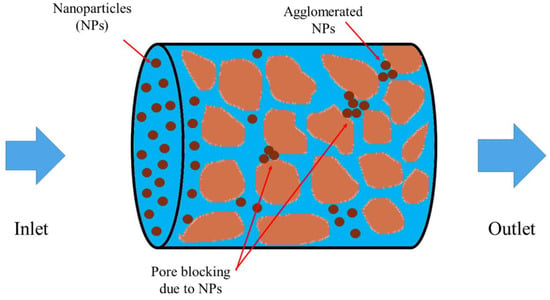
Figure 2.
Nanoparticle agglomeration and retention lead to pore blockage in reservoir core sample.
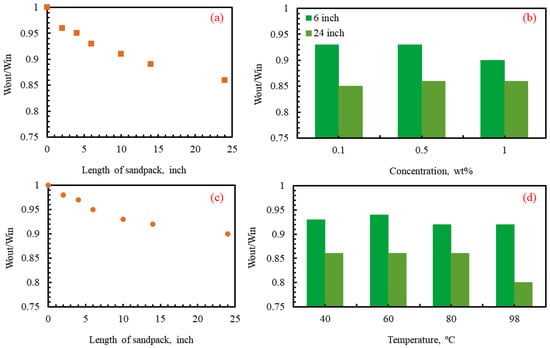
Figure 3.
Silica NP retention estimation (wout/win) in fabricated porous formation for varying experimental conditions: (a): flow rate of injection (1 mL/ min); (b): silica NP concentration; (c): flow rate of injection (2 mL/min), and (d): temperature (40–95 °C).
From Figure 3, it can be observed that silica NP retention is not of significant concern in most operating conditions. Even in the most severe case, only up to 16–18 wt% of silica NP was retained. Increasing the flow rate (from 1 mL/min in Figure 3a to 2 mL/min in Figure 3c) reduced the residence time of the silica NP inside the formation and hence, less silica NPs were retained. This makes a higher flow rate more desirable for increasing silica NP cost and performance effectiveness. Increasing temperature was found to have a marginal role on silica NP retention, as increasing temperature made the fluid more mobile and hence, the silica NPs easily displaceable. Increasing silica NP concentration led to a higher silica NP retention, as greater silica NP clusters were trapped inside the reservoir, though it was still not very significant. The most influential variable in the Figure 3 data was the length of the porous media, as a longer sand pack increases the residence time and available surface area for entrapment, causing more silica NPs to be held back inside the reservoir. However, most of the immediate silica NP retention was in the area near the inlet (as most larger clusters have been already stuck in that area), and the silica NP retention was more muted in sand pack sections >15 inches. A similar trend was also observed in past studies [26,39,40]. The presented results indicate that silica NP retention is most significantly influenced by the length of sand pack, with concentration playing a minor role in silica NP retention. The effects of flow rate and temperature on retention were more constrained; however, a slow flow rate that is too slow may increase silica NP retention, as the residence of the silica NPs would be significantly increased inside the reservoir, making them more prone to agglomeration, retention and capture.
3.3. Silica NP Retention in Saline Media and Its Mitigation Using Surfactants
Silica NP retention was then studied in saline media, as silica NP flooding is constrained by the presence of salt. Hence, the sand packs were saturated by 2 and 4 wt% saline water, respectively, and 0.5 wt% silica NP solution was injected through the system (Figure 4). The inclusion promotes rapid agglomeration of silica NPs inside the formation, which is highly detrimental to the silica NP efficacy [41]. silica NP agglomeration behavior in the presence of salt has been reported in detail in a previous study [25]. Silica NP retention was highly severe in the presence of salt, and in a longer sand pack of 24 inches, the silica NP retention in the presence of 2 wt%, less than 35 wt% of the silica NPs, was recovered at the other end. In the presence of 4 wt% salt, no silica NPs were observed at the outlet (also established by DLS), which indicated that most silica NPs were retained inside the sand pack.
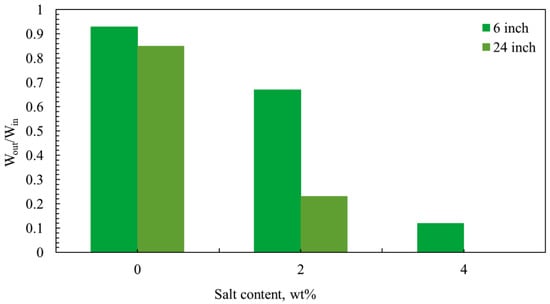
Figure 4.
Salt-induced nanoparticle agglomeration and retention in a fabricated porous media (Test temperature: 40 °C; flow rate of injection: 1 mL/min; concentration: 0.5 wt%).
The salt-induced agglomeration effect on silica NPs can be mitigated by the addition of an anionic surfactant, SDS, in the nanofluid. Compared to other surfactants, anionic surfactants have the tendency to adhere to the silica NP surface and resist its agglomeration by sterically stabilizing the mixture. Previous studies have explored the use of silica NP stabilization by SDS addition using DLS, zeta potential and rheology [41,42]. Hence, in this work, the surfactant-treated commercial silica nanofluids were injected in sand packs of varying lengths (6 and 24 inches), and their observed retention is provided in Figure 5. The saline medium was 4 wt% NaCl. Adding the surfactant, even in a lower quantity, increased the stability of the nanofluid and reduced the silica NP retention in the sand pack. The best results were obtained between 0.2–0.4 wt% of surfactant addition, with increasing surfactant concentration beyond that destabilizing the silica NP solution. This indicates that the addition of surfactant in an optimum quantity is able to mitigate the silica NP retention in a moderately saline reservoir. These observations are a great indicator for understanding the further constraints in exploring further use of silica NPs in saline conditions and possible solutions to mitigate their adverse effects.
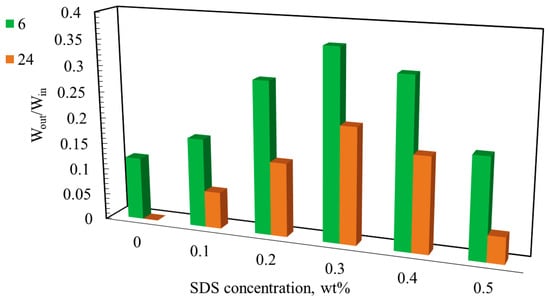
Figure 5.
Effect of surfactant addition on silica NP agglomeration and retention (Test temperature: 40 °C; flow rate of injection: 1 mL/min; concentration: 0.5 wt%).
Viscosity is a major factor influencing nanoparticle agglomeration in nanofluids. In water (and other fluids of similarly low viscosity), nanoparticle (silica NP) agglomeration is faster, as less energy is required for silica NPs to adhere to one another. However, when the viscosity of the solution is increased, a higher amount of energy is needed in order for silica NPs to agglomerate and sediment (Figure 6). Thus, compared to water-based nanofluids, polymeric nanofluids exhibit higher stability due to a greater hindrance to silica NP agglomeration on account of their superior viscosity.
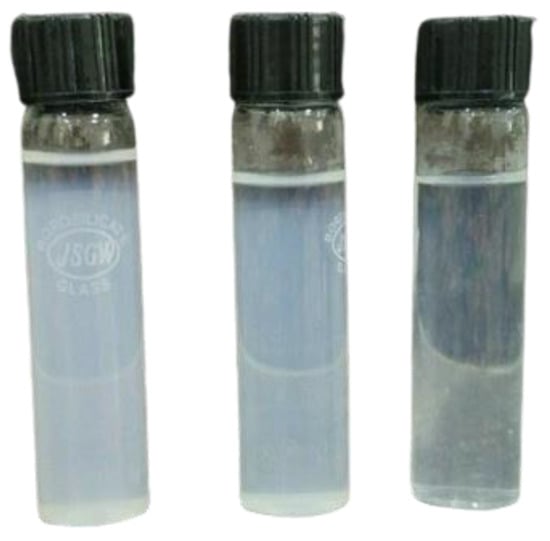
Figure 6.
Visual representations of the nanofluids in the laboratory.
3.4. Future Research Direction: Rise of AI
Artificial intelligence (AI) is an emerging field of technology which has wider applications in this industrial age. AI can help the hydrocarbon companies perform predictive maintenance by predicting the likelihood of failure in the machines and equipment of the setup by analyzing past data. This will enable the hydrocarbon companies to perform maintenance well before their equipment fails and causes losses of money, time and, in the most unfortunate circumstances, lives.
In preventing silica NP retention, artificial intelligence can play a great role by analyzing data from past investigations and experimental data to predict operating conditions where the nanofluids not only can give the best possible performance but can also negate any instance of silica NP retention by avoiding those conditions entirely. For this reason, it is essential to build a comprehensive database of experimental data which would then be used for the predictive analysis and methods to reduce silica NP agglomeration. This study is currently being carried out by the group and will be communicated separately as a new article.
4. Conclusions
This study discusses the constraints of using a commercial silica nanopowder in oilfield applications. The observations of this study underscore the existence of silica NP retention in sandstones, which was evident by the decrease in suspended silica NPs inside the effluent fluid (established by the decrease in weight of effluent fluid: Wout). While the increase in flow rate (from 1 mL/min to 2 mL/min) was found to reduce silica NP retention, increasing temperature was found to have a negligible effect on silica NP retention. A longer sand pack was more prone to retaining silica NPs than a smaller sand pack, though most of the silica NPs agglomerated in a shorter sand pack, with comparatively few silica NPs retained in larger sections (>14 inches) of the sand pack. Increasing silica NP concentration did not significantly impact the silica NP retention either, which is odd as higher concentrations of silica NPs make the fluid more prone to agglomeration. The most significant variable influencing silica NP retention was the salinity of the formation, which was expected, as salt-induced agglomeration is very severe. Silica NP retention was most severe in the 4 wt% NaCl reservoirs where no silica NP was observed in the outflow fluid after outflow from the 24-inch sand pack, indicating that silica NPs had agglomerated and been trapped inside the reservoir. The use of an anionic surfactant, SDS, was able to mitigate some of the most severe salt-induced agglomeration effects in the presence of 4 wt% NaCl. However, at higher concentrations of SDS, the synergistic effect was lost, and silica NP retention started to increase. Thus, from this study, it is clear that silica NP retention is an evident problem in subsurface flow applications, which may reduce the efficacy of various silica NP-related oil field applications.
Author Contributions
Conceptualization, S.B. (Sushant Bajpai); Data curation, M.S.; Formal analysis, M.S.; Investigation, N.S.; Methodology, S.B. (Sushant Bajpai), N.S. and M.S.; Project administration, S.K.T.; Resources, N.S.; Software, S.K.T.; Supervision, S.K.T. and S.B. (Susham Biswas); Validation, S.B. (Sushant Bajpai); Writing—review & editing, S.B. (Sushant Bajpai). All authors have read and agreed to the published version of the manuscript.
Funding
This research received no external funding.
Institutional Review Board Statement
Not Applicable.
Informed Consent Statement
Not Applicable.
Data Availability Statement
Not Applicable.
Acknowledgments
We thank the RGIPT for continued motivation, guidance and encouragement that makes the research at RGIPT top quality and worthy of their global peers. The authors also thank the Department of Chemical Engineering, RGIPT, for their valuable assistance in the exchange of information and acquisition of laboratory consumables for this study. Muskan Sonker would like to thank her seniors at Technip FMC and Johnson Mathey, Kanpur, for their valuable guidance, motivation and discussion, which made this work possible. Nehil Shreyash and Saurabh Kr. Tiwary would like to thank Wonder Cement, Nimbahera, Rajasthan, for allowing them to visit their industrial premises for field survey.
Conflicts of Interest
Authors declare no competing financial interest.
Sample Availability
Samples of the compounds are available from the authors and will be provided by the authors.
References
- Rai, S.; Tiwari, S. Nano Silica in Cement Hydration. Mater. Today Proc. 2018, 5, 9196–9202. [Google Scholar] [CrossRef]
- Gbadamosi, A.O.; Junin, R.; Manan, M.A.; Agi, A.; Yusuff, A.S. An overview of chemical enhanced oil recovery: Recent advances and prospects. Int. Nano Lett. 2019, 9, 171–202. [Google Scholar] [CrossRef] [Green Version]
- Thakkar, A.; Raval, A.; Chandra, S.; Shah, M.; Sircar, A. A comprehensive review of the application of nano-silica in oil well cementing. Petroleum 2020, 6, 123–129. [Google Scholar] [CrossRef]
- Fakoya, M.F.; Shah, S.N. Emergence of nanotechnology in the oil and gas industry: Emphasis on the application of silica nanoparticles. Petroleum 2017, 3, 391–405. [Google Scholar] [CrossRef]
- Chaturvedi, K.R.; Narukulla, R.; Sharma, T. CO2 capturing evaluation of single-step silica nanofluid through rheological investigation for nanofluid use in carbon utilization applications. J. Mol. Liq. 2020, 304, 112765. [Google Scholar] [CrossRef]
- Chaturvedi, K.R.; Sharma, T. Carbonated polymeric nanofluids for enhanced oil recovery from sandstone reservoir. J. Pet. Sci. Eng. 2020, 194, 107499. [Google Scholar] [CrossRef]
- Raghav Chaturvedi, K.; Kumar, R.; Trivedi, J.; Sheng, J.J.; Sharma, T. Stable Silica Nanofluids of an Oilfield Polymer for Enhanced CO2 Absorption for Oilfield Applications. Energy and Fuels 2018, 32, 12730–12741. [Google Scholar] [CrossRef]
- Shreyash, N.; Sonker, M.; Bajpai, S.; Tiwary, S.K.; Khan, M.A.; Raj, S.; Sharma, T.; Biswas, S. The Review of Carbon Capture-Storage Technologies and Developing Fuel Cells for Enhancing Utilization. Energies 2021, 14, 4978. [Google Scholar] [CrossRef]
- Zhou, D.-D.; Zhang, X.-W.; Mo, Z.-W.; Xu, Y.-Z.; Tian, X.-Y.; Li, Y.; Chen, X.-M.; Zhang, J.-P. Adsorptive separation of carbon dioxide: From conventional porous materials to metal–organic frameworks. EnergyChem 2019, 1, 100016. [Google Scholar] [CrossRef]
- Ogolo, N.A.; Olafuyi, O.A.; Onyekonwu, M.O. Enhanced oil recovery using nanoparticles. In Proceedings of the Society of Petroleum Engineers—SPE Saudi Arabia Section Technical Symposium and Exhibition, Al-Khobar, Saudi Arabia, 8–11 April 2012; pp. 276–284. [Google Scholar]
- Bila, A.; Stensen, J.Å.; Torsæter, O. Experimental investigation of polymer-coated silica nanoparticles for enhanced oil recovery. Nanomaterials 2019, 9, 822. [Google Scholar] [CrossRef] [Green Version]
- Park, K.J.; Jung, D. Boiling heat transfer enhancement with carbon nanotubes for refrigerants used in building air-conditioning. Energy Build. 2007, 39, 1061–1064. [Google Scholar] [CrossRef]
- Nguyen, C.T.; Roy, G.; Gauthier, C.; Galanis, N. Heat transfer enhancement using Al2O3-water nanofluid for an electronic liquid cooling system. Appl. Therm. Eng. 2007, 27, 1501–1506. [Google Scholar] [CrossRef]
- Trisaksri, V.; Wongwises, S. Nucleate pool boiling heat transfer of TiO2-R141b nanofluids. Int. J. Heat Mass Transf. 2009, 52, 1582–1588. [Google Scholar] [CrossRef]
- Bhattad, A.; Sarkar, J.; Ghosh, P. Improving the performance of refrigeration systems by using nanofluids: A comprehensive review. Renew. Sustain. Energy Rev. 2018, 82, 3656–3669. [Google Scholar] [CrossRef]
- Guo, X.; Zheng, S.; Luo, Y.; Pang, H. Synthesis of confining cobalt nanoparticles within SiOx/nitrogen-doped carbon framework derived from sustainable bamboo leaves as oxygen electrocatalysts for rechargeable Zn-air batteries. Chem. Eng. J. 2020, 401, 126005. [Google Scholar] [CrossRef]
- Yuan, M.; Guo, X.; Li, N.; Li, Q.; Wang, S.; Liu, C.-S.; Pang, H. Highly dispersed and stabilized nickel nanoparticle/silicon oxide/nitrogen-doped carbon composites for high-performance glucose electrocatalysis. Sens. Actuators B Chem. 2019, 297, 126809. [Google Scholar] [CrossRef]
- Azmi, W.H.; Sharif, M.Z.; Yusof, T.M.; Mamat, R.; Redhwan, A.A.M. Potential of nanorefrigerant and nanolubricant on energy saving in refrigeration system–A review. Renew. Sustain. Energy Rev. 2017, 69, 415–428. [Google Scholar] [CrossRef] [Green Version]
- Yilmaz, A.C. Performance evaluation of a refrigeration system using nanolubricant. Appl. Nanosci. 2020, 10, 1667–1678. [Google Scholar] [CrossRef]
- Kumar, R. Effect of Nanoparticles on Performance Characteristics of Refrigeration Cycle. In Low-Temperature Technologies; IntechOpen: London, UK, 2019; ISBN 978-1-83880-667-5. [Google Scholar]
- Chaturvedi, K.R.; Fogat, M.; Sharma, T. Low Temperature rheological characterization of single-step silica nanofluids: An additive in refrigeration and gas hydrate drilling applications. J. Pet. Sci. Eng. 2021, 204, 108742. [Google Scholar] [CrossRef]
- Peng, H.; Ding, G.; Jiang, W.; Hu, H.; Gao, Y. Heat transfer characteristics of refrigerant-based nanofluid flow boiling inside a horizontal smooth tube. Int. J. Refrig. 2009, 32, 1259–1270. [Google Scholar] [CrossRef]
- Kim, J.; Kang, Y.T.; Choi, C.K. Soret and Dufour effects on convective instabilities in binary nanofluids for absorption application. Int. J. Refrig. 2007, 30, 323–328. [Google Scholar] [CrossRef]
- Keykhosravi, A.; Simjoo, M. Insights into stability of silica nanofluids in brine solution coupled with rock wettability alteration: An enhanced oil recovery study in oil-wet carbonates. Colloids Surf. A Physicochem. Eng. Asp. 2019, 583, 124008. [Google Scholar] [CrossRef]
- Kumar, R.S.; Chaturvedi, K.R.; Iglauer, S.; Trivedi, J.; Sharma, T. Impact of anionic surfactant on stability, viscoelastic moduli, and oil recovery of silica nanofluid in saline environment. J. Pet. Sci. Eng. 2020, 195, 107634. [Google Scholar] [CrossRef]
- Chaturvedi, K.R.; Trivedi, J.; Sharma, T. Single-step silica nanofluid for improved carbon dioxide flow and reduced formation damage in porous media for carbon utilization. Energy 2020, 197, 117276. [Google Scholar] [CrossRef]
- Rao, K.S.; El-Hami, K.; Kodaki, T.; Matsushige, K.; Makino, K. A novel method for synthesis of silica nanoparticles. J. Colloid Interface Sci. 2005, 289, 125–131. [Google Scholar] [CrossRef]
- Natarajan, E.; Sathish, R. Role of nanofluids in solar water heater. Int. J. Adv. Manuf. Technol. 2009. [Google Scholar] [CrossRef]
- Kumar, R.S.; Sharma, T. Stability and rheological properties of nanofluids stabilized by SiO2 nanoparticles and SiO2-TiO2 nanocomposites for oilfield applications. Colloids Surf. A Physicochem. Eng. Asp. 2018, 539, 171–183. [Google Scholar] [CrossRef]
- Kumar, R.S.; Sharma, T. Stable SiO 2 –TiO 2 composite-based nanofluid of improved rheological behaviour for high-temperature oilfield applications. Geosystem Eng. 2020, 1–11. [Google Scholar] [CrossRef]
- Chaturvedi, K.R.; Singh, A.K.; Sharma, T. Impact of shale on properties and oil recovery potential of sandstone formation for low-salinity waterflooding applications. Asia-Pac. J. Chem. Eng. 2019, 14. [Google Scholar] [CrossRef]
- Goswami, R.; Chaturvedi, K.R.; Kumar, R.S.; Chon, B.H.; Sharma, T. Effect of ionic strength on crude emulsification and EOR potential of micellar flood for oil recovery applications in high saline environment. J. Pet. Sci. Eng. 2018, 170, 49–61. [Google Scholar] [CrossRef]
- Sharma, T.; Sangwai, J.S. Silica nanofluids in polyacrylamide with and without surfactant: Viscosity, surface tension, and interfacial tension with liquid paraffin. J. Pet. Sci. Eng. 2017, 152, 575–585. [Google Scholar] [CrossRef]
- Gosens, I.; Post, J.A.; de la Fonteyne, L.J.J.; Jansen, E.H.J.M.; Geus, J.W.; Cassee, F.R.; de Jong, W.H. Impact of agglomeration state of nano- and submicron sized gold particles on pulmonary inflammation. Part. Fibre Toxicol. 2010, 7, 37. [Google Scholar] [CrossRef] [Green Version]
- Sharma, T.; Iglauer, S.; Sangwai, J.S. Silica Nanofluids in an Oilfield Polymer Polyacrylamide: Interfacial Properties, Wettability Alteration, and Applications for Chemical Enhanced Oil Recovery. Ind. Eng. Chem. Res. 2016, 55, 12387–12397. [Google Scholar] [CrossRef]
- Dong, X.; Xu, J.; Cao, C.; Sun, D.; Jiang, X. Aqueous foam stabilized by hydrophobically modified silica particles and liquid paraffin droplets. Colloids Surf. A Physicochem. Eng. Asp. 2010, 353, 181–188. [Google Scholar] [CrossRef]
- Dehaghani, A.H.S.; Daneshfar, R. How much would silica nanoparticles enhance the performance of low-salinity water flooding? Pet. Sci. 2019, 16, 591–605. [Google Scholar] [CrossRef] [Green Version]
- Franco-Aguirre, M.; Zabala, R.D.; Lopera, S.H.; Franco, C.A.; Cortés, F.B. Interaction of anionic surfactant-nanoparticles for gas-Wettability alteration of sandstone in tight gas-condensate reservoirs. J. Nat. Gas. Sci. Eng. 2018, 51, 53–64. [Google Scholar] [CrossRef]
- Rognmo, A.U.; Horjen, H.; Fernø, M.A. Nanotechnology for improved CO2 utilization in CCS: Laboratory study of CO2-foam flow and silica nanoparticle retention in porous media. Int. J. Greenh. Gas. Control. 2017, 64, 113–118. [Google Scholar] [CrossRef]
- Babakhani, P. The impact of nanoparticle aggregation on their size exclusion during transport in porous media: One- and three-dimensional modelling investigations. Sci. Rep. 2019, 9, 14071. [Google Scholar] [CrossRef] [PubMed]
- Chaturvedi, K.R.; Sharma, T. Rheological analysis and EOR potential of surfactant treated single-step silica nanofluid at high temperature and salinity. J. Pet. Sci. Eng. 2021, 196, 107704. [Google Scholar] [CrossRef]
- Al-Anssari, S.; Arif, M.; Wang, S.; Barifcani, A.; Iglauer, S. Stabilising nanofluids in saline environments. J. Colloid Interface Sci. 2017, 508, 222–229. [Google Scholar] [CrossRef] [Green Version]
Publisher’s Note: MDPI stays neutral with regard to jurisdictional claims in published maps and institutional affiliations. |
© 2021 by the authors. Licensee MDPI, Basel, Switzerland. This article is an open access article distributed under the terms and conditions of the Creative Commons Attribution (CC BY) license (https://creativecommons.org/licenses/by/4.0/).